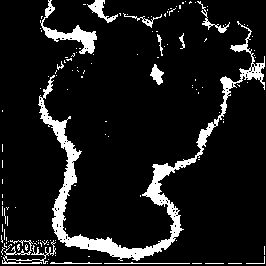Hollow hybrid microsphere for negative electrode material of lithium ion battery and preparation method
A technology of lithium-ion batteries and hybrid microspheres, applied in battery electrodes, secondary batteries, electrochemical generators, etc., can solve the problem of electrical conductivity that has not been effectively solved, electrochemical performance and electron/ion transmission capacity are limited, etc. question
- Summary
- Abstract
- Description
- Claims
- Application Information
AI Technical Summary
Problems solved by technology
Method used
Image
Examples
Embodiment 1
[0027] 1) Preparation of polystyrene template microspheres: Measure 11mL St and 0.5mL AA, add them dropwise to 90mL deionized water, stir for 30min with high-purity nitrogen, heat to 70°C, then add 10mL of 0.12g KPS Deionized aqueous solution was used as an initiator, and PS microspheres with a diameter of about 250nm could be obtained by stirring at 70°C for 12h.
[0028] 2) PS / TiO 2Preparation of hybrid microspheres: Take 0.5 g of PS microspheres prepared in step 1) and ultrasonically disperse them in 100 mL of ethanol, add 1 mL of TBOT and stir on a magnetic stirrer for 12 h, then add 50 mL of deionized water, and mix and stir for 12 h to make TBOT Hydrolyzed and self-assembled on the surface of microspheres to obtain PS / TiO 2 hybrid microspheres.
[0029] 3) PS / TiO 2 Preparation of / PDA hybrid microspheres: take 0.5 g of PS / TiO prepared in step 2) 2 The hybrid microspheres were ultrasonically dispersed in 400 mL of a mixed solvent with a volume ratio of ethanol: water ...
Embodiment 2
[0033] 1) Preparation of polystyrene template microspheres: according to Example 1.
[0034] 2) PS / TiO 2 Preparation of hybrid microspheres: Take 0.5 g of PS microspheres prepared in step 1) and ultrasonically disperse them in 100 mL of ethanol, add 0.5 mL of TBOT and stir on a magnetic stirrer for 12 h, then add 50 mL of deionized water, and mix and stir for 12 h to make TBOT was hydrolyzed and self-assembled on the surface of microspheres to obtain PS / TiO 2 hybrid microspheres.
[0035] 3) PS / TiO 2 Preparation of / PDA hybrid microspheres: according to Example 1.
[0036] 4) PS / TiO 2 / PDA / MoS 2 Preparation of hybrid microspheres: according to Example 1.
[0037] 5) TiO 2 / C / MoS 2 Preparation of hybrid microspheres: according to Example 1.
Embodiment 3
[0039] 1) Preparation of polystyrene template microspheres: according to Example 1.
[0040] 2) PS / TiO 2 Preparation of hybrid microspheres: carried out according to Example 1
[0041] 3) PS / TiO 2 Preparation of / PDA hybrid microspheres: take 0.5 g of PS / TiO prepared in step 2) 2 The hybrid microspheres were dispersed in a 400mL mixed solvent with a volume ratio of ethanol: water = 7: 1 by ultrasound, 0.2g Tris and 0.5g DA were added, and mixed and stirred for 24h at room temperature. DA was mixed in PS / TiO 2 Polymerization on the surface of microspheres to obtain PS / TiO 2 / PDA hybrid microspheres.
[0042] 4) PS / TiO 2 / PDA / MoS 2 Preparation of hybrid microspheres: according to Example 1.
[0043] 5) TiO 2 / C / MoS 2 Preparation of hybrid microspheres: according to Example 1.
PUM
| Property | Measurement | Unit |
|---|---|---|
| size | aaaaa | aaaaa |
| thickness | aaaaa | aaaaa |
| thickness | aaaaa | aaaaa |
Abstract
Description
Claims
Application Information
 Login to View More
Login to View More - R&D Engineer
- R&D Manager
- IP Professional
- Industry Leading Data Capabilities
- Powerful AI technology
- Patent DNA Extraction
Browse by: Latest US Patents, China's latest patents, Technical Efficacy Thesaurus, Application Domain, Technology Topic, Popular Technical Reports.
© 2024 PatSnap. All rights reserved.Legal|Privacy policy|Modern Slavery Act Transparency Statement|Sitemap|About US| Contact US: help@patsnap.com










